从摇篮到独角兽 以太坊公共物品融资的周期理论
撰文:Carl Cervone,Kevin Owocki
来源:ChainFeeds
编译:纯真
编者按:开源项目分析产品 Open Source Observer 团队成员 Carl Cervone 和 Gitcoin 联合创始人 Kevin Owocki 联合撰文拆解了以太坊生态公共物品的融资周期,以及每个周期中存在的问题和机遇。本文为公共物品的周期性研究提供了基础框架,其中提到的机遇作为构建方向有较大的借鉴价值。
TLDR
本文讨论了以太坊公共物品的端到端融资生命周期;
我们认为,解决这些问题可以为加密货币生态系统创造可持续的竞争优势;
我们概述了公共物品融资的生命周期:
摇篮阶段侧重于构建和获得初始资金;
成熟阶段包括社区建设和在「悲伤低谷」中生存;
独角兽阶段是关于实现重大影响并获得追溯性资金。
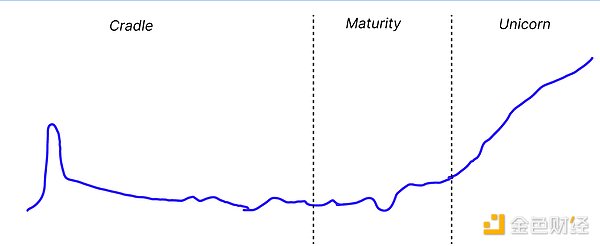
私人物品融资项目生命周期
有一张著名的图表展示了一家初创企业的生命周期:从首次被 TechCrunch 报道,到逐渐失去新鲜感,再到长期的「悲伤低谷」,最后跨越鸿沟,以数十亿美元的价格出售。
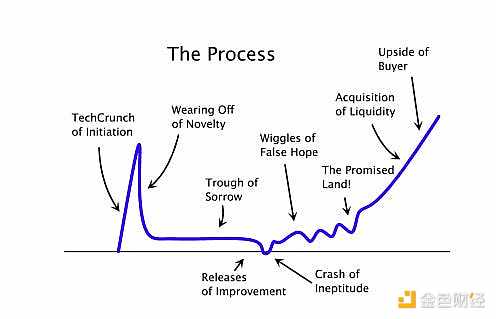
这类初创企业通常由风险投资公司提供资金。它们中的大多数都死于低谷,因为它们在找到产品与市场契合点之前就耗尽了资金。
初创企业的融资基础架构已经相当完善:它们会获得一些风险投资的初始资金,以围绕自己的想法打造产品;如果他们进入增长阶段,他们会获得更多的风险投资(和收入);最终,如果一切顺利,当公司出现流动性事件时,每个人都会从他们投入的资金中获得巨大回报。
此外,还有一个由不同出资人组成的价值链,他们专门为不同类型和阶段的初创企业提供资金。早期投资者往往与后期投资者截然不同。早期投资者大多把赌注押在人身上,因此他们需要专业的领域知识和网络才能找到好的交易。后期投资者更注重数字,因此他们将密切关注公司的指标和宏观情况。这一领域的投资者可以提供宝贵的资源,包括教育、招聘、指导等。
公共物品融资项目生命周期
让我们考虑一下以太坊公共物品生态系统的类似资金生命周期图可能是什么样子,理想情况下是在团队产生影响之前、期间和之后为其提供资金。
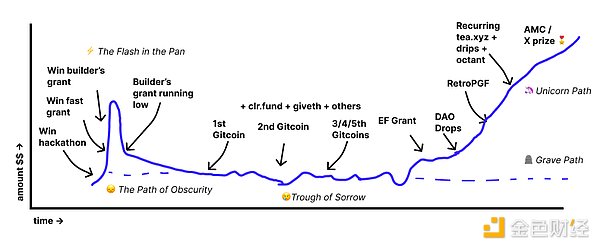
为了加快创新,在公共物品组织生命周期的「从摇篮到独角兽」阶段,每个可行的项目都应得到资助。
此外,还需要持续提供资金、验证和其他资源,以帮助项目度过从最初建设到成为独角兽的「悲伤低谷」。并非所有项目都能成功。事实上,大多数项目都不会。如果项目最终夭折,团队继续前进,我们也不应该因此而感到耻辱(我们尤其应该鼓励将这些团队的经验教训公之于众,以免未来的团队重蹈覆辙)。
1. 摇篮:潜在融资阶段
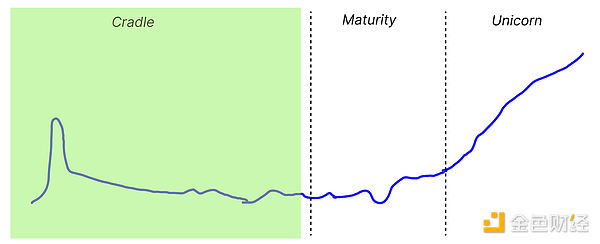
在起步阶段(上图的早期到中期),需要资金来降低创业的前期成本。人们害怕辞职,申请很多助学金项目既困难又耗时。
但是,提供资金也不能不经过审查。为了真正帮助建设者,建设者还需要验证哪些东西能为多少人创造价值。在获得资金的同时,还需要验证你的工作是否重要。
赏金和黑客马拉松是播种创意的好方法,但它们是不可预测的,会刺激团队不断转换项目 / 跳转生态系统。从赢得几场小型黑客松到获得一笔大型拨款,应该有更好的途径,也许中间还有几笔中等规模的快速拨款。这将有助于更多的项目启动,并为经过考验的建设者提供一条更容易的辞职从而全职从事该工作的道路。这也有助于让建设者专注于特定的生态系统,而不是从一笔拨款跳到另一笔拨款。
在摇篮阶段,项目应专注于最重要的事情:建设。他们应该尽可能在公共场合进行建设。任何可以简化他们生活 + 使他们专注于建设 / 学习的事情,无论是寻找保险还是雇佣一位优秀的智能合约审计员,都是值得的。理想情况下,他们不应花太多时间担心下一笔资金的来源。
在我们的示意图中,这个阶段从赢得黑客马拉松开始,到获得以太坊基金会的小额资助结束。他们还没有产生任何真正的影响,但他们已经证明值得获得大量的潜在资金去构建一些东西。
2. 成熟:社区融资阶段

现在这个项目有一些资金,但运行得非常不理想。它正在构建和尝试不同的东西,但往往还没有人真正关心。
「悲伤低谷」就像项目的熊市。当你的「悲伤低谷」与资金熊市同时出现时,这就更难了。
为了度过「悲伤低谷」,成长为一个成熟的公共物品项目,你需要建立一个社区,并开始对这些人产生真正可证明的影响。这是像二次方融资和直接赠款这样的社区资助机制最有价值的阶段。
尽管大多数项目无法通过这种方式筹集到 10 万美元,但他们应该能够获得足够的资金来维持生存和继续发展。这些机制迫使项目与社区保持密切联系,并提高社区意识。
在 Gitcoin Grant 表现最好的项目是那些已经存在并建立了声誉的项目,而不是那些通过 Gitcoin 向世界宣布自己存在的项目。我们观察到包括 clr.fund 和 Giveth 在内的其他资助平台也是如此。
最好的项目都是在这一阶段成熟起来的,在社区中因提供有用的公共物品从而享有良好的声誉。
3. 独角兽:追溯性融资阶段
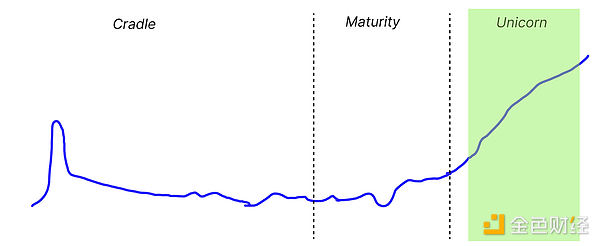
在某些时候,项目会出现一个拐点,对生态系统造成的影响会远远超过获得的公平补偿。我们希望这就是大量追溯性资金发挥作用的地方。
理想情况下,我们将开始看到各种互补机制为这些项目提供资金。ETH 的质押收益或 ETF 利润(如 Van Eck)将授予声誉卓著的项目。增加 Optimism RetroPGF 轮次,它们由一群徽章持有人决定分配。
当前,这些大多是技术层面的机制,但随着时间的推移,公共产品项目有望带来更多自下而上的经常性收入。tea.xyz 和 Drips v2 提供了不同的资金组合方式。这个想法可以扩展到任何形式的公共物品。我们在追踪影响和创建奖励上游影响的文化方面做得越好,这就越有可能成为公益项目的一个可行的经常性收入来源。
最后,如果能为公共物品设立相当于 X 奖或大型预先市场承诺(AMC)的奖项,那将会是一件令人兴奋的事情。
4.死亡(有时)是一种特性,而不是一个错误
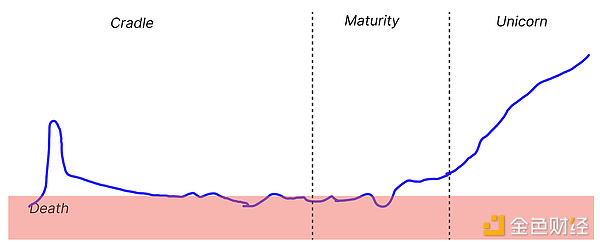
许多项目无法实现可持续发展,也无法成为独角兽,而是在发展过程中夭折。在某些情况下,这是一种特性,而不是一个错误。
当一个项目失败时,它可以为企业家、投资者和更广泛的社区提供宝贵的经验教训。其中一个主要教训是市场需求的重要性:许多项目之所以失败,是因为它们创造的产品或服务不能满足强烈的需求。这凸显了全面市场调研和持续的客户反馈的必要性。一个失败的项目也能凸显时机的重要性。即使是最有创意的想法,也需要在市场需求开始出现的时候提出。
另一个关键经验是灵活性和适应性的重要性。项目往往是在快速变化的环境中运作的,能否根据市场变化、客户反馈或技术进步做出调整,对项目的生存至关重要。失败还教会了我们团队动力和领导力的重要性。项目失败的一个常见原因是内部冲突或缺乏明确的领导力和愿景。因此,建立一个与初创企业目标一致的强大、有凝聚力的团队与创意本身同样重要。
作为生态系统的建设者,最重要的是:
如果项目走在正确的道路上,就不要让项目因为缺乏资金而夭折;
如果建设者走在错误的道路上,则应加快死亡 / 反思 / 复兴之路;
如果项目最终夭折,团队也应继续前进,这不应该成为耻辱。我们尤其应该鼓励公开这些团队的经验教训,这样未来的团队就不会犯同样的错误。
5. 并非每个成功的项目都是独角兽
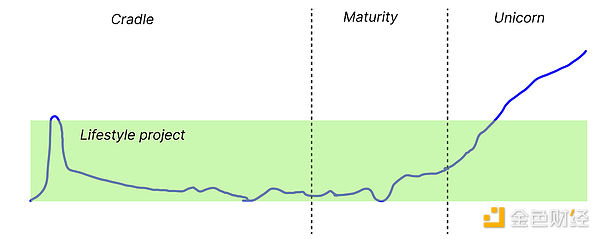
也许「独角兽或死亡」是错误的框架。许多项目并不想成为独角兽。事实上,对独角兽的崇拜是风险投资模式的遗留问题,在这种模式下,整个过程都取决于能否找到一个 100 倍的退出机会,从而使你的全部资金得到回报。
需要有一种针对公共那个物品的生活方式和商业模式——有机会构建一些规模较小但能提供巨大价值的工具,但这些工具永远无法实现指数级增长——即改变世界或成为独角兽。
建议和开放性问题
1. 不断做大蛋糕
我们可以从风险投资 / 初创企业中得出的一个相似之处是,成功的创始人可以成为下一代投资者。
我们可以看到,当代独角兽公司在摇篮阶段为下一代公共产品项目提供资金。这种情况已经发生了,像 1inch 和 Uniswap 这样的项目从 Gitcoin Grant 接收者变成了匹配池捐赠者和 Protocol Guild 的捐赠者。这应该在社会层面得到鼓励。
我们可以通过创建可信的加密承诺来为下一代项目提供资金,从而增强社会层的动力。如果每个在摇篮阶段获得资金的新项目都发布一份 EAS 证明,表明他们计划将 5% 的代币用于下一代项目,那么这就为下一代的公共产品资金创造了一个可量化的未来承诺。
机遇:
如果下一代建设者成为独角兽,我们如何吸引他们做出回馈公共产品的高度诚信承诺?
我们如何开展一场社会运动,使其成为趋势?
我们如何将这些承诺汇集起来,为未来的资助做出可信的承诺?
2.RetroPGF 提供了围绕「影响=利润」的机会
VC 推动初创公司加速并获取尽可能多的价值。公共产品的推力应该是为生态系统创造尽可能多的价值。
追溯性公共物品融资提供了一个机会,推动一种不同的价值捕获机制,该机制与「影响=利润」的模式相融合。
通过将追溯性公共物品融资引入生态系统,我们可以为产生最大影响的公共产品创造一个可靠的货币回报承诺。由于追溯比预期更容易判断项目质量,因此追溯性融资更接近「影响 = 利润」。
但这样一来,未来的公益事业资助者就可以改变资助生命周期的前期步骤。使得投机者推测哪些公益最有可能在日后获得追溯回报。允许用户在周期早期对公共物品进行「天使投资」的工具可能会促进这方面的发展。
另一个机会是创建影响力证明,以可信的方式跟踪哪些项目产生的影响最大。这些大规模的影响力证明将形成一个信任网络,让所有项目都能证明彼此的影响力。像 EAS 和 Hypercerts 这样的工具可以为这些影响证明提供基础。当鲸鱼资助者利用这些工具作为信号检测来决定资助什么项目时,它们就变得越来越有价值,它们也可以作为建设者了解自己是否走在正确道路上的宝贵工具。
机遇:
将 Hypercerts/EAS 纳入现有的公共物品资助项目
建立新的影响力证明服务,帮助人们区分哪些是有影响力的项目
建立新的前瞻性公共产品融资工具,从而获得未来的追溯奖励。
3.在摇篮阶段活下来
创造一条可靠的途径来度过摇篮阶段是这个领域最重要的未解决问题。
此处的开放问题包括:
如果一个建设者未能吸引到资金 / 证明,那是因为生态系统有问题,还是因为该建设者尚未找到一个重要到值得资助的问题领域?
公共物品建设者特别需要什么样的安全网?逆向思维: 如何建立这些安全网才能使其不被利用?
肯定有一些服务是所有团队都需要的,如法律、后台、招聘、审计、办公时间等。这些服务是否会成为小型团队独立自主的关键?
其中哪些服务对处于摇篮阶段的建设者最有价值?摇篮阶段每项新服务的 TAM 是多少?如果 TAM 足够大,我们就会看到服务于这些利基市场的公司不断涌现。如果 TAM 足够大,我们如何聚集 DAO,让它们集中资源提供这些服务?我们如何吸引建设者来提供这些服务?
虽然资助是一个良好的开端,但一旦开发人员和生态系统良好合作,就需要向这种关系迈出第二步,即让开发者感到舒适和「宾至如归」的长期关系。当我们对协议了如指掌,并能在生态系统中建立长期关系时,开发人员的工作才能做得最好。指哪儿打哪儿的模式并不好。开发人员如何从阶段性融资过渡到经常性融资?
4. 我们只是在重塑风险投资吗?
在某些方面,这个生态系统的融资生命周期可能开始类似于风险投资的重塑。
在风险投资中,基金通常会积累一批优秀的开发人员和其他服务提供商,他们可以为创始人提供所需的任何帮助。
我们应该发扬这里的成功经验,但也要注意从第一原则出发重塑这些生态系统服务的机会。
可组合的融资模式为建设者提供了拥有多种不同资金和服务来源的机会(而不是一家风险投资公司)。
追溯性公共物品融资为建设者提供了关注公共产品的机会,而不仅仅是那些能提取价值的东西。价值由网络获取,并反馈给网络。
Web3 系统的超模块化也是一个机会。由于智能合约具有反竞争性,使用的人越多,价值就越大,因此有机会在早期为指数增长曲线提供动力,从而在日后获得回报。
解决这个问题的是 META
解决「从摇篮到独角兽」的公共产品融资问题是否为加密生态系统创造了一种新的 META(最有效的策略)?
我们相信,随着加密货币的成熟和基本面的日益重要,为生态系统的公共产品提供资金将成为一种可持续的竞争优势,就像工作、学校、医疗保健和娱乐是城市的竞争优势一样。
亲社会行为在世界各地的经济 / 自然生态系统中独立进化了几十次(狼群一起捕食、人类联合起来组建公司或国家等等)。在我们看来,它显然也会进化到加密经济系统中。
从某种意义上说,「以太坊联盟」这一主题已经在发生了。采用亲以太坊思维和商业模式的项目可以享受到在一个相互支持的网络中的诸多特权(无论是出于利他主义还是理性的经济利益,都希望看到两者取得成功)。
随着生态系统的发展,有机会将这种心态扩展到以太坊生态系统中大量存在的上千个 DAO 中。每个项目都在价值链中争得一席之地以增加价值,这些项目将在其社区内引导亲社会环境。

在这篇文章中,我们研究了如何在公共产品项目的整个生命周期中做到这一点——从摇篮到独角兽,或者从摇篮到死亡。
The source of the article compiles the pure editor's note. The team members and co-founders of the open source project analysis product team wrote an article to dismantle the financing cycle of Ethereum ecological public goods and the problems and opportunities in each cycle. This paper provides a basic framework for the periodic research of public goods, and the opportunities mentioned in it are of great reference value as the construction direction. This paper discusses the end-to-end financing life cycle of Ethereum public goods. We believe that solving these problems can create a cryptocurrency ecosystem. Sustainable competitive advantage: We have outlined the cradle stage of the life cycle of public goods financing, focusing on building and obtaining initial funds. The mature stage includes community building and surviving in the sad valley. The unicorn stage is about achieving significant impact and obtaining traceability funds. There is a famous chart showing the life cycle of a start-up enterprise from being first reported to gradually losing its freshness to a long-term sad valley, and finally crossing the gap by billions of dollars. Selling at a price, these start-ups are usually funded by venture capital companies, and most of them die at a low ebb because they run out of funds before finding the fit point between the products and the market. The financing infrastructure of start-ups is quite perfect, and they will get some initial funds of venture capital to build products around their own ideas. If they enter the growth stage, they will get more venture capital and income. Finally, if all goes well, when the company has a liquidity event, everyone will. In addition, there is a value chain composed of different investors who specialize in providing funds for start-ups of different types and stages. Early investors are often very different from late investors. Early investors mostly bet on people, so they need professional domain knowledge and networks to find good transactions. Later investors pay more attention to numbers, so they will pay close attention to the company's indicators and macro situation. For valuable resources, including education, recruitment guidance and other public goods financing project life cycle, let's consider what the similar capital life cycle diagram of the public goods ecosystem in Ethereum might look like. Ideally, it is to provide funds for the team before, during and after its impact. In order to accelerate innovation, every feasible project should be funded in the life cycle of public goods organizations from cradle to unicorn, and in addition, it is necessary to continuously provide financial verification and other resources to help the project. Not all projects can be successful, in fact, most projects will not. If the project finally dies, the team will continue to move forward, and we should not be ashamed of it. In particular, we should encourage the publicity of the experience and lessons of these teams in order to avoid the future team repeating the same mistakes. The potential financing stage is in the initial stage. People are afraid of quitting their jobs and applying for many bursary projects. It's difficult and time-consuming, but providing funds can't be without review. In order to really help builders, builders also need to verify what can create value for how many people. While obtaining funds, you also need to verify whether your work is important. Bounty and hackathon are good ways to sow ideas, but they are unpredictable and will stimulate teams to constantly change projects and jump into the ecosystem. There should be a better way to win a few small hackathon games and get a large grant. Maybe there are a few medium-sized ones in the middle. This will help more projects to start and provide a way for the tested builders to quit their jobs and engage in the work full-time. It will also help the builders to focus on a specific ecosystem instead of jumping from one grant to another. In the cradle stage, projects should focus on the most important things, and they should build in public as much as possible, anything that can simplify their lives and make them focus on construction and learning, whether it is looking for insurance or hiring. It is worthwhile to be an excellent smart contract auditor. Ideally, they should not spend too much time worrying about the source of the next fund. In our schematic diagram, at this stage, from winning the hackathon to getting a small grant from the Ethereum Foundation, they have not had any real impact, but they have proved that it is worth getting a lot of potential funds to build something. At the mature community financing stage, this project has some funds, but it is running very unsatisfactory. It is under construction. Build and try different things, but often no one really cares about the sad trough, just like the bear market of the project. When your sad trough and the capital bear market appear at the same time, it is even more difficult. In order to get through the sad trough and grow into a mature public goods project, you need to build a community and start to have a truly demonstrable impact on these people. This is the most valuable stage of community funding mechanisms such as secondary financing and direct grants, although most projects cannot raise million dollars in this way. But they should be able to get enough funds to survive and continue to develop. These mechanisms force projects to keep close contact with the community and raise community awareness. The best projects are those that already exist and have established a reputation, not those that have announced their existence to the world. We have observed that other funding platforms, including Hehe, are also the same. The best projects are all mature at this stage and enjoy a good voice in the community because they provide useful public goods. In the retrospective financing stage of the reputation unicorn, at some point, the project will have an inflection point, and the impact on the ecosystem will far exceed the fair compensation. We hope that this is where a large number of retrospective funds come into play. Ideally, we will start to see various complementary mechanisms to provide funds for these projects, such as pledge income or profits, which will be awarded to prestigious projects for additional rounds, and they will be decided by a group of badge holders. At present, these are mostly technical mechanisms, but over time. With the passage of time, public goods projects are expected to bring more bottom-up recurrent income and provide different ways of fund combination. This idea can be extended to any form of public goods. The better we do in tracking the impact and creating a culture that rewards the upstream impact, the more likely it is to become a feasible source of recurrent income for public goods. Finally, if we can set up awards equivalent to awards or large-scale pre-market commitments for public goods, it will be an exciting thing. Sometimes death is a feature rather than a mistake. Many projects cannot achieve sustainable development and cannot become unicorns, but are developing. 比特币今日价格行情网_okx交易所app_永续合约_比特币怎么买卖交易_虚拟币交易所平台
注册有任何问题请添加 微信:MVIP619 拉你进入群

打开微信扫一扫
添加客服
进入交流群
1.本站遵循行业规范,任何转载的稿件都会明确标注作者和来源;2.本站的原创文章,请转载时务必注明文章作者和来源,不尊重原创的行为我们将追究责任;3.作者投稿可能会经我们编辑修改或补充。


















